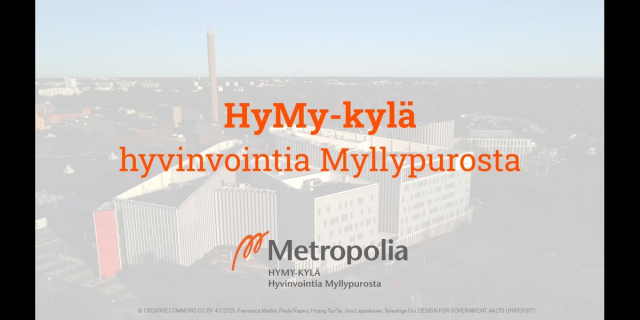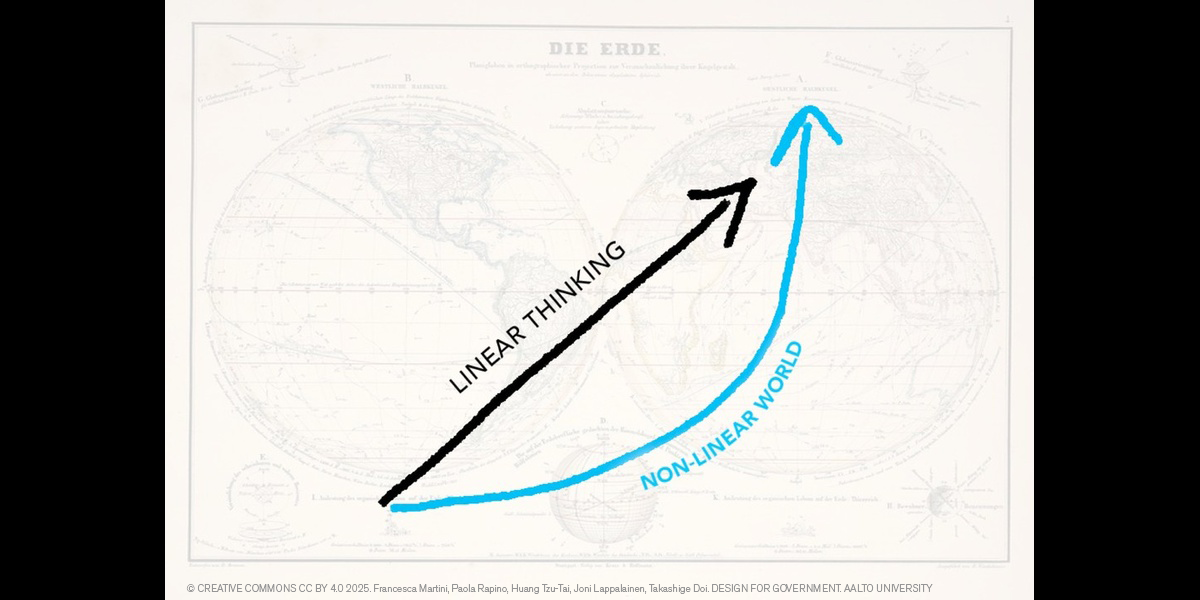This blog post reports on work-in-progress within the DfG course! The post is written by group Care 1 dealing with Kela, the Social Insurance Institution of Finland’s brief on “Continuity of Knowledge” in healthcare. The group includes Francesca Martini from Creative Sustainability program (Aalto University), Paola Rapino from Creative Sustainability (Aalto University, Exchange), Huang Tzu-Tai from Sustainable Entrepreneurship (Aalto University), and Joni Lappalainen and Takashige Doi from the Collaborative and Industrial Design program (Aalto University).
Written by: Huang Tzu-Tai
Human perspective plays a crucial role in Finland’s healthcare system. Today, advanced digital platforms allow professionals to access patient information and summaries with ease. Yet, the reality is more complex: fragmentation between digital systems, as well as unrecorded or informal knowledge creates persistent challenges for continuity of care. This disconnect is a classic case of what Donella Meadows calls “linear minds in a nonlinear world”. (Meadows, 2008) While our tools and processes are designed for straightforward, predictable flows, real-life care is interconnected, adaptive, and often unpredictable. In this post, I want to dig into where things stand now and explore what’s next for digital solutions in healthcare beyond just chasing shiny technological fixes.
The Pitfalls of Linear Thinking in Healthcare
In Thinking in Systems, the author highlights how linear thinking fails to address the complexity of real-world systems. Finnish healthcare’s reliance on metrics like cost-per-patient or hospital waiting times exemplify this mindset. However, outcomes such as elderly patients’ long-term well-being also depend on nonlinear interactions between medical, social, and psychological factors and actors. Despite tools like Kanta, which centralize medical records, critical knowledge such as a patient’s social context or informal caregiving information often remains unrecorded or scattered in different systems and professionals. Digital records may streamline documentation, but if key social or behavioral insights remain outside the system, the patient’s true needs are not fully understood or addressed.
“Basic care needs, for example, hygiene and eating. The elderly are lonely and have a need to talk. Memory disorders challenged the staff and made everyday life harder for other clients.” -nurse
In Finnish healthcare, system traps such as “fixes that fail” showcase the result of introducing new digital tools without addressing the nonlinear reality of fragmentation and problems in continuity of knowledge.
“I’ve faced so many times in my life situations in which some very important information escaped, and something happened because that specific information that would have been very important in that moment was in a different system.”-administrative personnel
“Too much time is spent on tech and data handling and contacting different parties.”-nurse
A quote from administrative personnel and another quote from a nurse from our fieldwork research post the nonlinear challenge to healthcare. Certainly, linear thinking ways such as digital solutions alone are far from perfect to address the main issue.

Figure 1. Hymy village: human centered approach in Finnish healthcare system
The value of human-centered approaches
From the fieldwork research, our group found that Metropolia’s HyMy Village is a promising step toward bridging this gap. HyMy Village brings professionals, clients, and stakeholders to co-create solutions together from the earliest stages of service planning to evaluation. By offering a collaborative digital environment for professionals, patients, and families, HyMy Village shares not only medical data such as medical and test results but also real-life experiences. It is more like a community hub where stakeholders exchange practical knowledge in the village. This method can be integrated into service planning and evaluation. When critical information is missing or unclear in digital systems, human interaction allows professionals to fill in the gaps, clarify uncertainties, and respond flexibly to real-time needs. I would like to highlight counseling services in the village that provide elderly’s need to be heard.
“I remember last autumn, one lady who said that I have friends, but I have a feeling that no one really listens to me. And straight ahead, she took appointment for every week.” – administrative personnel
This holistic approach reflects the nonlinear reality of care: continuity of knowledge is not about more data; it’s about connecting the dots between numbers and stories. This inclusive approach strengthens involvement, empowers individuals, and ensures that services are flexible and responsive to real needs. HyMy Village demonstrates a possible future how critical human perspective in Finnish healthcare can move beyond linear metrics.

Figure 2. Human interaction plays a critical role in continuity of knowledge
Human Perspective and Collaboration: The Foundation for Continuity of Knowledge
Continuity of knowledge in elderly care not only implies a technical or administrative challenge, but it also presents a challenge for the ways in which people interact, share, and interpret information across the care system. Linear approaches, which assume that data can simply be transferred from one digital platform to another, often fail to capture the nonlinear realities in elderly care. In practice this means that changes in mood, social support, or informal caregiving arrangements may be unrecorded, fragmented, or buried within standardized documentation. Fragmentation persists not only between digital systems but also between care domains (doctors, nurses, social workers, etc.) making it difficult to achieve a comprehensive view of a patient’s needs. Overcoming these barriers requires more than just technical integration. Nurses, social workers, and doctors each observe different aspects of an elderly person’s life, and their insights create more understanding than any single data source can provide.
“Nurse is always looking like this narrow. It’s the paradigm, one of their professions, is very different, because we look at the whole human…… when you’re a nurse or doctor, you say, what is the problem with their hand? What kind of medication can I give you?……And the physiotherapist came and said, okay, what kind of exercise can you do so you get better?…… We talk, then there’s also always some other problem or some other issue coming out, so that’s the very holistic view.”
Just as well, social workers play a crucial role in transferring experience-based knowledge that may not be formally documented, ensuring that emotional well-being, preferences, and informal care of the elderly are recognized and integrated into care planning.
Conclusion
Continuity of knowledge in healthcare requires reimagining our systems to reflect the nonlinear, human-centered nature of care. Initiatives like HyMy Village show that by making everyone’s expertise visible and fostering collaboration across disciplines, we can address fragmentation in digital systems and build a more adaptive, human-based healthcare system for the future.
References
HYMy Village – Well-being and Health Village. (2025, May 6). Metropolia UAS. https://www.metropolia.fi/en/services/well-being-and-health-village
Kivinen T, Vanjusov H & Vornanen R. Asiakkaan ääni– osallisuus ja vaikuttamisen mahdollisuudet. Teoksessa: Hujala A, Taskinen H (toim.) Uudistuva sosiaali- ja terveysala. Tampere: University Press 2020, 267-293. https://trepo.tuni.fi/bitstream/handle/10024/124087/kivinen_ym_asiakkaan_aani_osallisuus_ja_vaikuttamisen.pdf?sequence=2
Weiste, E., Käpykangas, S., Uusitalo, L., & Stevanovic, M. (2020). Being Heard, Exerting Influence, or Knowing How to Play the Game? Expectations of Client Involvement among Social and Health Care Professionals and Clients. International Journal of Environmental Research and Public Health, 17(16), 5653. https://doi.org/10.3390/ijerph17165653
Wright, D., & Meadows, D. H. (2008). Thinking in systems. https://cds.cern.ch/record/1608083
The DfG course runs for 14 weeks each spring – the 2025 course has now started and runs from 24th Feb to 27th May. It’s an advanced studio course in which students work in multidisciplinary teams to address project briefs commissioned by governmental ministries in Finland. The course proceeds through the spring as a series of teaching modules in which various research and design methods are applied to address the project briefs. Blog posts are written by student groups, in which they share news, experiences and insights from within the course activities and their project development. More information here about the DfG 2025 project briefs. Hold the date for the public finale on Tuesday 27th May!

